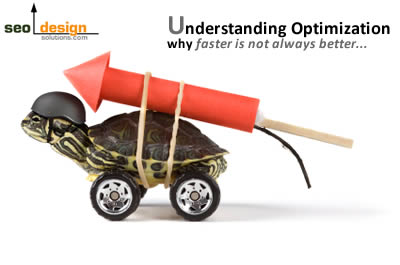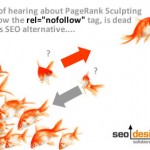With SEO, being faster is not always better. When you are targeting competitive keywords, slow and steady wins the race.

Just as what goes up must come down, understanding the dips, peaks and valleys of search engine algorithms and how they impact the search engine result pages is a work in progress.
You’ve heard of link velocity, but what about optimization velocity? Grasping the phases of optimization in layman’s terms can help you prepare for these cycles and use them to maximize the best possible trajectory for long-term SEO results.
The Ping Phase – Much like a love affair, this is the introduction or the courtship phase with search engines known as the fresh link factor. If you have a blog or an RSS feed whenever you publish or modify content, then your site can technically build its own backlinks as a result of aggregating itself through a feed (much like a broadcast).
Depending on the number of feeds you ping with your blog, your pages can ride this phase for weeks for a website with authority, otherwise it can take 1-2 weeks before your SERP (search engine result page) relationship sinks and your page is no longer the flavor of the week or considered a hot scoop for search engine spiders.
When you see your content beginning to wane (slip and recede), then it’s time to master the gap on a page by page basis and start looking for other methods to support your page during its chrysalis from caterpillar to butterfly (but first you need links to promote buoyancy).
The Gap – This typically happens in 1-2 months for most sites, the spike in traffic, the affair with search engines blooms then they leave you for a hotter, fresher story (based on the same topic as yours).
Ideally, you should monitor when your search engine rankings slip using analytics and SEO tools, then you can stay ahead of the curve when the pressure from competition arises as well as when to move into the next phase of optimization.
After the dip, if you page has donned enough references, links or traffic, then you can make it out of the gap only slipping back 10 positions or so, which still puts you in the game as a contender for a top spot after you build internal link weight or infuse the site with some type of link popularity.
Link Insurance – this is the phase where its time to link to your links, or in some way shape or form create SEO mitosis for your pages.
The idea here is to diversify the types of backlink support you offer your pages. For example (1) using deep links to get things rising to the top, using directories and building links to sub folders or sitemaps to create stemming of link flow (to feed individual pages), using article marketing (author’s boxes) to push a page over the threshold (with i.p diversity) or other like tactics are a method that has worked in the past.
The Authority Ranking – This is the goal, the page has transformed itself into a butterfly from a caterpillar at this stage, true authority is developed (especially if a site higher up on the food chain links to you) and your pages start to take on the grandfather effect (6-9 months).
This is when those two word trophy keywords (equip with bragging rights) that seemed nearly impossible (if you can still remember why) are starting to shape up as you see glimpses of light at the end of the tunnel.
This is where you go back to basics and make sure your web pages do not suffer from lack-of-link-itis and get punted to the back of the line. Look for other pages to prop your hay maker page up and lean into some real rankings with your new found authority.
When a page reaches the top 10, utilize it using the buddy system to augment you older content by using the first steps (1) the fresh link factor and (2) link insurance / deep linking above from another page to support additional rankings.
Every word is a keyword under the right circumstances which can be cultivated as a result of positioning, age, links and prominence. The idea is to manage multiple pages (and at least 3 targeted key phrases per page) through the cycles of waning, waxing and optimization to settle in the top 10 results when the gestation period is concluded.
The threshold of how many pages, how many links and how long it will take is all contingent on the prowess of your competition and the authority and technique of the pages that targeted the keywords before you.
However, the real battle is not with your competition, only with your own website and its relevance for the keywords or percentage of market share the pages and links are targeting respectively. Time is an asset if you understand page and link velocity, you can either work against it or use it to support your optimization efforts (if you understand the signals search engines produce).











Where do you get the cool pictures from?
Wow, Amazing stuff. Really I love your plans and strategies that will easily generate traffic to our websites, and also your images are superb. Thank you